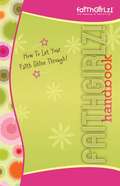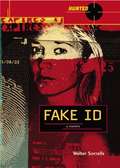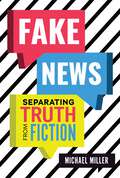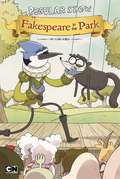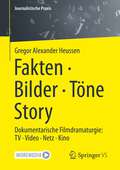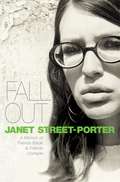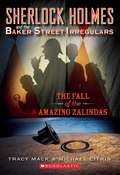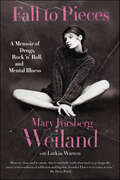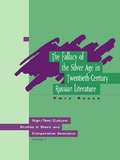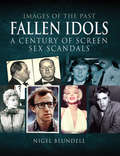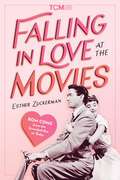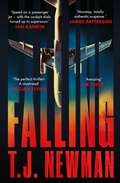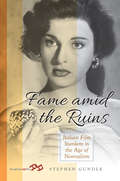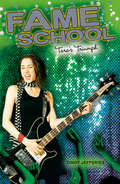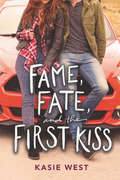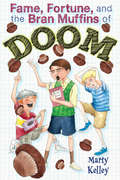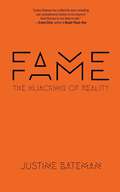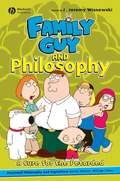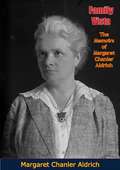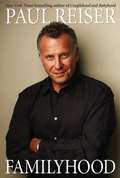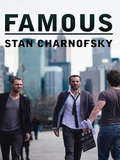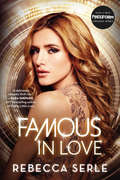- Table View
- List View
Faithgirlz Handbook, Updated and Expanded: How to Let Your Faith Shine Through (Faithgirlz)
by Suzanne HadleyThe Faithgirlz! Handbook is full of activities, Bible stories, and discussion questions that will bring girls and their friends closer to God and more in touch with his Word. Here is everything girls need to start their own Faithgirlz club and to connect more deeply with God, the Bible, and their friends!
Fake ID (Hunted #1)
by Walter SorrellsOn the night of Chastity's 16th birthday, her mother disappears. Police find blood matching her mother's DNA, but Chass doesn't believe her mother is dead. If Chass can't find her mother in six days, she'll be placed in foster care--or murdered first.
Fake News: Separating Truth from Fiction
by Michael MillerWhile popularized by President Donald Trump, the term "fake news" actually originated toward the end of the 19th century, in an era of rampant yellow journalism. Since then, it has come to encompass a broad universe of news stories and marketing strategies ranging from outright lies, propaganda, and conspiracy theories to hoaxes, opinion pieces, and satire—all facilitated and manipulated by social media platforms. This title explores journalistic and fact-checking standards, Constitutional protections, and real-world case studies, helping readers identify the mechanics, perpetrators, motives, and psychology of fake news. A final chapter explores methods for assessing and avoiding the spread of fake news.
Fakespeare in the Park
by Gabe SoriaHast thou heard of Shakespeare in the Park? Bro, this is so much cooler. Mordecai and Rigby are trying to slack off again, only this time it's about to ruin The Park's Shakespeare festival. This clever novel presents a light-hearted story of how Mordecai and Rigby from Regular Show try their hardest to get out of work and in the process wreak havoc on the festival in The Park. As usual, they must rely on their friends to help them cleanest up thy mess.
Fakten · Bilder · Töne · Story: Dokumentarische Filmdramaturgie: TV · Video · Netz · Kino (Journalistische Praxis)
by Gregor Alexander HeussenDokumentarische Filme aller Genres in TV, Kino und Netz entfalten ihre informative Kraft erst dann, wenn sie dramaturgisch als Erzählungen strukturiert sind, nicht als Aufzählungen. Sie müssen die Emotionen des Publikums wecken, damit die filmische Information verstanden werden kann. Wirksame dokumentarische Filmgestaltung ist begründet in der Art, wie Menschen hinschauen und hinhören. Ihre Wahrnehmungen werden zu Vorstellungen; diese prägen die Information. Dadurch verändern sich viele überkommene Regeln für Dokumentarische Filme. Neue Ideen werden möglich. Werkzeuge dafür sind der Erzählsatz, die Roten Fäden, die Drama-Elementarmuster, das konzentrierte Zusammenspiel der sechs filmischen Erzähler, Emotionsziel und Argumentziel und die für Erzählungen charakteristische Polaritätslogik. Anders als fiktionale Filme müssen Dokumentarische Filme durch ihre erzählerische Struktur und filmische Gestaltung einen nachprüfbaren Bezug zur Lebensrealität des Publikums schaffen. Spielfilme hingegen können in ihrem jeweils definierten Erzählkosmos plausibel und authentisch sein. Im Dokumentarischen lassen sich auch Werkzeuge und Muster der Fiktionalen Dramaturgie nutzen, aber mit anderer Absicht und Wirkung: sie müssen die Lebensrealität treffen. Das Buch von Gregor Alexander Heussen zeigt Dokumentarische Dramaturgie praktisch; und begründet sie mit Erkenntnissen der Kognitionswissenschaft. Redakteure* und Film-Auftraggeber* finden Werkzeuge und Denkwege für Planung, und Filmabnahme. Autoren* erfahren die Kraft der dramaturgischen Recherche und entdecken neue Gestaltungsmöglichkeiten bei Dreh und Montage. Das Buch ist ein Muss für alle, die sich für dokumentarischen Film in TV, Kino, Netz und Unternehmen interessieren. Mit dem Buch sind 29 runterladbare, sofort nutzbare Drama-Werkzeuge verlinkt.
Fall Out
by Janet Street-PorterFriends. Everyone needs them. Especially when relations between you and your family are less than perfect. And for the talented and ambitious Janet Street-Porter, her friends became her family. is the story of these vibrant characters – some famous, some infamous, all extraordinary – and their often volatile relationships with her. Above all, it is a portrait of an exciting and creative era, by someone who lived it to the full.
Fall Out
by Janet Street-PorterFriends. Everyone needs them. Especially when relations between you and your family are less than perfect. And for the talented and ambitious Janet Street-Porter, her friends became her family. is the story of these vibrant characters – some famous, some infamous, all extraordinary – and their often volatile relationships with her. Above all, it is a portrait of an exciting and creative era, by someone who lived it to the full.
Fall of the Amazing Zalindas (Sherlock Holmes and the Baker Street Irregulars #1)
by Tracy Mack Michael CitrinFew know Sherlock Holmes was assisted by a band of devoted boys--street urchins who loved to solve mysteries--called the Baker Street Irregulars. In this exciting tale Sherlock Holmes solve the case of the deaths of the Amazing Zalindas.
Fall to Pieces: A Memoir of Drugs, Rock 'n' Roll, and Mental Illness
by Larkin Warren Mary Forsberg WeilandFall to Pieces is a beautifully written, visceral, roller coaster ride inside bipolar disorder, rock ’n’ roll, celebrity culture, and the world of modeling. Mary Forsberg Weiland, ex-wife of the late Scott Weiland, front man for Stone Temple Pilots and Velvet Revolver, tells a harrowing true story of depression, drug addiction, and mental illness with candor and, often, humor. Co-written with veteran journalist Larkin Warren, Fall to Pieces is a blistering, eye-opening memoir of Hollywood meltdown in the bestselling vein of Tatum O’Neal’s A Paper Life and Valerie Bertinelli’s Losing It.
Fallacy of Silver Age
by Omry RonenIn this study, Ronen critically examines the term "Silver Age", which over the years has gained such wide currency among historians and connoisseurs of 20th century Russian culture. The author traces the origin and the controversial development of what he condemns as an influential misnomer. Ronen sets out to debunk the myth that attributes invention of the term to Nikolai Berdiaev, and in turn traces this widely used catchword in the critical idiom from an abscure, avante-garde manifesto to the present day. He lays to rest the use of the term which he sees as the most misleading constituent of Russia's contemporary cultural self-awareness and self-assessment.
Fallen Idols: A Century of Screen Sex Scandals (Images of the Past)
by Nigel BlundellIts a scandal! How often we use that phrase and what a catalogue of sins it covers. Thats what this book is all about. It is literally a catalogue of sins committed by some of the most celebrated names on the planet.Within these covers are startling stories of scandals during a century when screen idols seemed to vie with each other in outraging public decency. It was an age when fan fever was at its height and an endless supply of shocking revelations emerged to fuel the frenzy.Because of the perpetrators superstar status, the shame of exposure was often heightened, not only wrecking reputations but often harming careers and, at least, ensuring very public humiliation.The lessons learned from these cases of celebrity scandal (though often, it seems, not by the celebrities themselves) is that the bigger the star, the harder the fall and that deceit and intrigue so often turn hard-won fame into instant infamy.
Falling in Love at the Movies: Rom-Coms from the Screwball Era to Today (Turner Classic Movies)
by Esther ZuckermanPrepare to swoon, ugly cry, laugh, and fall in love with this officially licensed exploration of the impact and legacy of one of film's most beloved genres from Turner Classic Movies: the rom-com. Romantic comedies have had an incredible influence on popular culture, shaping everything from how we think of relationships to fashion. Often swept aside in film history, these movies are thought of as pure comfort viewing. Although they certainly provide those fuzzy feelings, they have also had a significant artistic influence and cultural impact. Spanning decades of romantic comedies—from movies of the 1930s such as It Happened One Night and the rom com craze of the 80s and 90s including When Harry Met Sally...all the way to contemporary hits like Crazy Rich Asians, and everything in between—Falling in Love at the Movies will make you fall in love (all over again) with romantic comedies. Esther Zuckerman—accomplished entertainment journalist and member of the New York Film Critic&’s Circle—takes readers on a journey through the rom-com. She examines the aspects that make us so drawn to these types of films, diving deep into the key auteurs—from Preston Sturges to James L. Brooks to Nora Ephron and beyond—who both created and subverted the canon. These directors, actors, and writers shaped the genre, establishing and also busting traditional pillars and tenets of these movies such as the &“Perfect Pair&” or &“The Man in Crisis&” and &“The High Maintenance Woman.&” Featuring full-color images from the films throughout, along the way Zuckerman takes detours, explores iconic lines of dialogue (Who could forget Julia Roberts' &“I&’m also just a girl, standing in front of a boy, asking him to love her&” iconic moment from Notting Hill?) to memorable scenes (the magical moment at the Empire State Building in Sleepless in Seattle) and weaves in interviews of artists and romantic comedy fanatics in the industry. Looking beyond the traditional rom-com, Zuckerman digs into the nooks and crannies, the films that buck the trend of "happily ever after," the ones that think beyond heteronormative narratives, and the indies that kept the rom-com alive outside of the studio system, to offer a more comprehensive story of the rom-com than has ever been seen before—and one that you&’re bound to love. How&’s that for a happy ending?
Falling: the most thrilling blockbuster read of the summer
by T. J. NewmanPRE-ORDER THE PAPERBACK EDITION OF DROWNING, THE THRILLING NEW BLOCKBUSTER BY T. J. NEWMAN. OUT JUNE 2024. &‘Amazing . . . Intense suspense, shocks and scares plus chilling insider authenticity make this one very special&’ LEE CHILD 'FALLING is the best kind of thriller (for me as a reader anyway). Characters you care deeply about. Nonstop, totally authentic suspense' JAMES PATTERSON&‘Attention, please: T. J. Newman has written the perfect thriller! GILLIAN FLYNN, #1 bestselling author of Gone GirlYou just boarded a flight to New York.There are one hundred and forty-three other passengers onboard.What you don&’t know is that thirty minutes before the flight your pilot&’s family was kidnapped.For his family to live, everyone on your plane must die.The only way the family will survive is if the pilot follows his orders and crashes the plane. Enjoy the flight. ***Praise for Falling*** &‘Think Speed on a passenger jet - with the cockpit dials turned up to supersonic&’ Ian Rankin &‘Stunning and relentless. This is Jaws at 35,000 feet&’ Don Winslow &‘The best thriller I&’ve read in years. Buckle up&’ Adrian McKinty &‘Attention, please: T. J. Newman has written the perfect thriller! ... Terrific and terrifying, a true page-turner.. A must-read for summer vacation' Gillian Flynn, #1 bestselling author of Gone Girl &‘A jet-propelled thriller that will have you in its grip from first page to last. A truly astonishing debut and an incredible work of pure suspense&’ Steve Cavanagh 'Newman keeps up an extreme pace from the first page—a near-impossible task, considering that the hero is locked in a cockpit, unable to take action himself. This novel is like the films Die Hard and Speed on steroids, creating one of the year&’s best thrillers' Library Journal &‘With characters you&’ll root for and a plot that dips and bounces like a plane hitting turbulence, this thrill ride is impossible to put down&’ Daily Mail &‘A scorching thriller&’ Evening Standard 'Newman&’s [flight attendant] background means Falling brings a freshness and depth to the genre' The Guardian 'A superlative debut . . . This tense, convincing thriller marks the arrival of an assured new talent' Publishers Weekly ' ...full of the kind of authentic detail that comes from personal experience' Literary Review &‘Gripping from the first sentence, this thriller is like no other&’ OK! Magazine 'A remarkable debut' The Sunday Times '... a tense and claustrophobic read, the fast-paced action zipping along at an astonishing rate' Refinery29
Fame Amid the Ruins: Italian Film Stardom in the Age of Neorealism
by Stephen GundleItalian cinema gave rise to a number of the best-known films of the postwar years, from Rome Open City to Bicycle Thieves. Although some neorealist film-makers would have preferred to abolish stars altogether, the public adored them and producers needed their help in relaunching the national film industry. This book explores the many conflicts that arose in Italy between 1945 and 1953 over stars and stardom, offering intimate studies of the careers of both well-known and less familiar figures, shedding new light on the close relationship forged between cinema and society during a time of political transition and shifting national identities.
Fame Amid the Ruins: Italian Film Stardom in the Age of Neorealism
by Stephen GundleItalian cinema gave rise to a number of the best-known films of the postwar years, from Rome Open City to Bicycle Thieves. Although some neorealist film-makers would have preferred to abolish stars altogether, the public adored them and producers needed their help in relaunching the national film industry. This book explores the many conflicts that arose in Italy between 1945 and 1953 over stars and stardom, offering intimate studies of the careers of both well-known and less familiar figures, shedding new light on the close relationship forged between cinema and society during a time of political transition and shifting national identities.
Fame School #5 (Tara's Triumph)
by Cindy JeffriesTara is following her dream of becoming a bass guitar rock star. But when roommates Pop and Lolly tell her about an African school for orphans, Tara decides that helping others is more important than becoming famous. <P><P>A charity CD seems like a great way to raise money, since Tara is surrounded by talented friends and teachers at Rockley Park school. But before long, she realizes that the CD is much more work, and trouble, than she bargained for. Tara needs a lot of help--and a little ingenuity--to pull it all together. Will she succeed? Or will all her hard work be wasted?
Fame, Fate, and the First Kiss
by Kasie WestFan favorite author Kasie West delivers an effervescent story about chasing your dreams and following your heart, perfect for fans of Jenny Han and Huntley Fitzpatrick. Lacey Barnes has dreamed of being an actress for as long as she can remember. So when she gets the opportunity to star in a movie alongside one of Hollywood’s hottest actors, she doesn’t hesitate to accept the part.But Lacey quickly learns that life in the spotlight isn’t as picture perfect as she imagined. She’s having trouble bonding with her costars, her father has hired the definition of a choir boy, Donavan Lake, to tutor her, and somewhere along the way she’s lost her acting mojo. And just when it seems like things couldn’t get any worse, it looks like someone on set is deliberately trying to sabotage her. As Lacey’s world spins out of control, it feels like the only person she can count on—whether it’s helping her try to unravel the mystery of who is out to get her or snap her out of her acting funk—is Donavan. But what she doesn’t count on is this straight-laced boy becoming another distraction.With her entire future riding on this movie, Lacey knows she can’t afford to get sidetracked by a crush. But for the first time in her life Lacey wonders if it’s true that the best stories really do happen when you go off script.
Fame, Fortune, and the Bran Muffins of Doom
by Marty KelleySimon's latest scheme is to gain everlasting fame and glory by winning the school talent show. What stands in his way? A lot. There's the fact that he doesn't sing, dance, or play a musical instrument. There's nasty Mike McAlpine and his cronies. There's Stacy and her distracting brown eyes. And last, but certainly not least, is Mrs. Annand, who insists on bombarding Simon and his friends with dangerously hard muffins while they rehearse their act. Utter humiliation is looking a lot more likely than fame and glory for Simon's band, The Groovy Guys.
Fame, Glory, and Other Things on My To Do List
by Janette RallisonIt's been a week and a half since Brendan broke up with me, but I try not to think about him. He only crosses my mind when I see Lauren and him walking around the hallways holding hands, or when they eat lunch in the cafeteria sitting so close together you'd think they were Siamese twins, or when I cry myself to sleep every night. But besides all of that, I'm doing really well. On the night I met Jordan, I wasn't thinking about Brendan at all. After my shift at Wal-Mart was over, I walked out into the parking lot debating the merits of boy names for girls instead of dwelling on the fact that it was Friday night and Brendan and Lauren were out somewhere practicing their Siamese twins routine.
Fame: The Hijacking of Reality
by Justine Bateman"Wholly riveting."--New York Times Book Review"Justine Bateman was famous before selfies replaced autographs, and bags of fan mail gave way to Twitter shitstorms. And here's the good news: she took notes along the way. Justine steps through the looking glass of her own celebrity, shatters it, and pieces together, beyond the shards and splinters, a reflection of her true self. The transformation is breathtaking. Revelatory and raucous, fascinating and frightening, Fame is a hell of a ride."--Michael J. Fox, actor, author of A Funny Thing Happened on the Way to the Future"In a new book, Fame: The Hijacking of Reality, the two-time Emmy nominee takes a raw look at the culture of celebrity, reflecting on her stardom at its dizzying peak--and the 'disconcerting' feeling as it began to fade."--People MagazineA Book Soup (Los Angeles, CA) best seller, October 15–21, 2018"As the title Fame: The Hijacking of Reality more than implies, this is a book about the complicated aspects of all things fame."--Vanity Fair"Bateman digs into the out-of-control nature of being famous, its psychological aftermath and why we all can't get enough of it."--New York Post"The Family Ties alum has written the rawest, bleakest book on fame you're ever likely to read. Bateman's close-up of the celeb experience features vivid encounters with misogyny, painful meditations on aging in Hollywood, and no shortage of theses on social media's wrath."--Entertainment Weekly"Bateman addresses the reader directly, pouring out her thoughts in a rapid-fire, conversational style. (Hunter S. Thompson is saluted in the acknowledgments.)...But her jittery delivery suits the material--the manic sugar high of celebrity and its inevitable crash. Bateman takes the reader through her entire fame cycle, from TV megastar, whose first movie role was alongside Julia Roberts, to her quieter life today as a filmmaker. She is as relentless with herself as she is with others."--Washington Post"While Bateman's new book Fame: The Hijacking of Reality (out now) touches on the former teen starlet's experience in the public eye, it's not a memoir. Far from it, in fact--it's instead an intense meditation on the nature of fame, and a glimpse into the repercussions it has on both the individual experiencing it and the society that keeps the concept alive."--Entertainment Weekly"Bateman takes an unsentimental look at the nature of celebrity worship in her first book, Fame: The Hijacking of Reality."--LA WeeklyEntertainment shows, magazines, websites, and other channels continuously report the latest sightings, heartbreaks, and triumphs of the famous to a seemingly insatiable public. Millions of people go to enormous lengths to achieve Fame. Fame is woven into our lives in ways that may have been unimaginable in years past.And yet, is Fame even real? Contrary to tangible realities, Fame is one of those "realities" that we, as a society, have made. Why is that and what is it about Fame that drives us to spend so much time, money, and focus to create the framework that maintains its health?Mining decades of experience, writer, director, producer, and actress Justine Bateman writes a visceral, intimate look at the experience of Fame. Combining the internal reality-shift of the famous, theories on the public's behavior at each stage of a famous person's career, and the experiences of other famous performers, Bateman takes the reader inside and outside the emotions of Fame. The book includes twenty-four color photographs to highlight her analysis.
Family Guy and Philosophy: A Cure for the Retarded
by J. Jeremy WisnewskiWisnewski (philosophy, Hartwick College) provides the analysis and some of the funny footnotes as he and his contributors work through postmodernism, religion and religious exclusivity, virtue and perversity, clueless men (in the character's case this is an oxymoron), motherhood, deadly sins, the importance of background people, dogs with personality, the logic of expectation, humor, fallacies, plagiarism, will and wantonness in wives, ego, and death. The result is fun, if you are a fan of the show, but even if you are not, you can get the point and most of the jokes.
Family Vista: The Memoirs of Margaret Chanler Aldrich
by Margaret Chanler AldrichFirst published in 1958, these are the memoirs of Margaret Chanler Aldrich, a descendant of the prominent Astor family. A nurse for the American Red Cross during the Spanish-American War, and later the Philippine-American War, Aldrich joined the woman’s suffrage movement and became notable as one of Carrie Chapman Catt’s capable officials in the campaign for suffrage in New York State.A fascinating autobiography!
Familyhood
by Paul ReiserFor the longest time, based on no evidence other than our own insecurity and sense of incompetence, my wife and I were convinced that we were the flat-out, no-question-about-it, least-skilled parents in the country. Furthermore, we were convinced that every other set of parents we knew was perfect. They were more thorough in going over their kids' homework, they set better boundaries than we do, didn't let their kids watch as many hours of TV as we do, raised kids who are unfailingly polite in public and have a far greater sense of community and public service than our underachieving offspring over there on the couch watching SpongeBob. We were certain everybody else's kids willingly and joyfully eat nothing but healthy foods, shunning all candy and candy-based products, they all sensibly and automatically put on weather-appropriate clothing, and voluntarily call their grandparents with clockwork regularity, giving fully detailed accounts of their numerous accomplishments, ending with testimonials to their wonderful and perfect parents.Turns out: not so much. At all.In the number one New York Times bestseller Couplehood, Paul Reiser wrote about the highs and lows of falling in love and getting married-and the heartbreak and hilarity that comes with it. In Babyhood, he turned his sharply observant eye to the experiences of having a brand-new family. And now in Familyhood, Reiser shares his observations on parenting, marriage, and mid-life with the wit, warmth, and humor that he's so well-known for.From the first experience of sending his two boys off to summer camp-the early feelings of gleeful freedom in an empty house, to realizing how empty the house actually was-to maneuvering the minefield of bad words learned at school, this hilarious new book captures the spirit of familyhood, the logical next frontier for Reiser's trademark perspective on the universal truths of life, love, and relationships.
Famous
by Stan CharnofskyWealthy, mega-successful parents reared Harry Schiff to hunger for fame and fortune. At college he sees others throw off family fiats and successfully begin to define themselves. He meets Juliet, driven to be an actor, sensuous, passionate, yet never with commitment. His good friend, Katy Bloom, also a striving actor, becomes his confidante, secretly in love with him. A fourth buddy, Galen Thurston, an Adonis, blessed with Hollywood connections, gets a seeming break because of his father, but with strings. A tragedy explodes when Galen discovers his father’s ugly secret. The group’s chemistry is altered with an intrigue that involves both Harry’s and Galen’s parents. Juliet is on her rocket to fame, her own family’s tale so sordid that she cannot tolerate her father’s presence. Is Harry Juliet’s toy? She would deny it, but eventually, Harry must face off his two demons: his parents’ domination and Juliet’s emotional indifference. Resolution comes when he gets a heady break, screws up his courage to confront his issues, and sees Katy Bloom in another light. To be true to himself becomes more important than to become famous.
Famous in Love
by Rebecca Serle"A must-read for anyone curious about life and love behind the scenes."--Bella Thorne, actor and author of Autumn FallsWhen seventeen-year-old Paige Townsen gets plucked from obscurity to star in the movie adaptation of a blockbuster book series, her life changes practically overnight. Within a month, Paige has traded the quiet streets of her hometown for a bustling movie set on the shores of Maui, and she is spending quality time with her costar Rainer Devon, one of People's Sexiest Men Alive. But when troubled star Jordan Wilder lands the role of the other point in the movie's famous love triangle, Paige's crazy new life begins to resemble her character's. In this coming-of-age romance inspired by the kind of celeb hookups that get clever nicknames and a million page views, Paige must figure out who she is -- and who she wants -- while the whole world watches.
